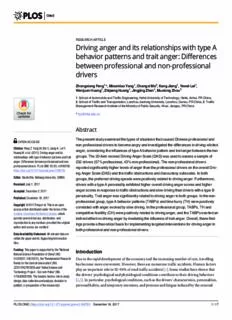Table Of ContentRESEARCHARTICLE
Driving anger and its relationships with type A
behavior patterns and trait anger: Differences
between professional and non-professional
drivers
ZhongxiangFeng1*,MiaomiaoYang1,ChangxiMa2,KangJiang1,YeweiLei1,
WenjuanHuang1,ZhipengHuang1,JingjingZhan1,MuxiongZhou3
a1111111111 1 SchoolofAutomobileandTrafficEngineering,HefeiUniversityofTechnology,Hefei,Anhui,PRChina,
2 SchoolofTrafficandTransportation,LanzhouJiaotongUniversity,Lanzhou,Gansu,PRChina,3 Traffic
a1111111111
ManagementResearchInstituteoftheMinistryofPublicSecurity,Wuxi,Jiangsu,PRChina
a1111111111
a1111111111
*fzx@hfut.edu.cn
a1111111111
Abstract
ThepresentstudyexaminedthetypesofsituationsthatcausedChineseprofessionaland
OPENACCESS
non-professionaldriverstobecomeangryandinvestigatedthedifferencesindriving-elicited
Citation:FengZ,YangM,MaC,JiangK,LeiY,
anger,consideringtheinfluencesoftypeAbehaviorpatternandtraitangerbetweenthetwo
HuangW,etal.(2017)Drivingangerandits
groups.The20-itemrevisedDrivingAngerScale(DAS)wasusedtoassessasampleof
relationshipswithtypeAbehaviorpatternsandtrait
anger:Differencesbetweenprofessionalandnon- 232drivers(57%professional,43%non-professional).Thenon-professionaldrivers
professionaldrivers.PLoSONE12(12):e0189793. reportedsignificantlyhigherlevelsofangerthantheprofessionaldriversontheoverallDriv-
https://doi.org/10.1371/journal.pone.0189793
ingAngerScale(DAS)andthetrafficobstructionsanddiscourtesysubscales.Inboth
Editor:XiaoleiMa,BeihangUniversity,CHINA groups,thepreferreddrivingspeedswerepositivelyrelatedtodrivinganger.Furthermore,
Received:July1,2017 driverswithatypeApersonalityexhibitedhigheroveralldrivingangerscoresandhigher
angerscoresinresponsetotrafficobstructionsandslowdrivingthandriverswithatypeB
Accepted:December2,2017
personality.Traitangerwassignificantlyrelatedtodrivingangerinbothgroups.Inthenon-
Published:December18,2017
professionalgroup,typeAbehaviorpatterns(TABPs)andtimehurry(TH)werepositively
Copyright:©2017Fengetal.Thisisanopen
correlatedwithangerevokedbyslowdriving.Intheprofessionalgroup,TABPs,THand
accessarticledistributedunderthetermsofthe
competitivehostility(CH)werepositivelyrelatedtodrivinganger,andtheTABPsexertedan
CreativeCommonsAttributionLicense,which
permitsunrestricteduse,distribution,and indirecteffectondrivingangerbymediatingtheinfluenceoftraitanger.Overall,thesefind-
reproductioninanymedium,providedtheoriginal ingsprovideatheoreticalbasisforimplementingtargetedinterventionsfordrivingangerin
authorandsourcearecredited.
bothprofessionalandnon-professionaldrivers.
DataAvailabilityStatement:Allrelevantdataare
withinthepaperanditsSupportingInformation
files.
Funding:Thispaperissupportedbythe"National
Introduction
NaturalScienceFoundationofChina"(NO.
51578207,51678211),the"FundamentalResearch Duetotherapiddevelopmentoftheeconomyandtheincreasingnumberofcars,travelling
FundsfortheCentralUniversities"(NO. hasbecomemoreconvenient.However,therearenumeroustrafficaccidents.Humanfactors
JZ2017HGTB0209)and"AnhuiScienceand
playanimportantrolein92–94%ofroadtrafficaccidents[1].Somestudieshaveshownthat
TechnologyProject-Sci-techPolice"(NO.
thedrivers’psychologicalandphysiologicalconditionscontributetotheirdrivingbehaviors
1704d0802189).Thefundershadnoroleinstudy
[2,3].Inparticular,psychologicalconditions,suchasthedrivers’characteristics,personalities,
design,datacollectionandanalysis,decisionto
publish,orpreparationofthemanuscript. personalhabits,andtemporaryemotions,andpressureandfatigueinducedbytheexternal
PLOSONE|https://doi.org/10.1371/journal.pone.0189793 December18,2017 1/17
DrivingangeranditsrelationshipswithtypeAbehavioralpatternsandtraitanger
Competinginterests:Theauthorshavedeclared environmentsignificantlyinfluencedrivingbehaviors.Duetotheincreasinglyrapidpaceof
thatnocompetinginterestsexist. modernurbanlife,peopleaccumulatestressandnegativeemotionsfromtheirdailylivesor
work.Roadrage,whichisanegativeemotionthatoccurswhiledriving,hasbecomeacommon
occurrenceworldwide[4].Sincethemid-1990s,thisphenomenonhasbeguntodrawmedia
attention.Forexample,in1994,psychologistsfromColoradoStateUniversitydefineddriving
angerasthepropensitytobecomeangrywhiledriving[5].However,drivingangerislikely
morecommonthancurrentlybelievedandislikelyexperiencedregularlybynormaldrivers.A
previousstudyfoundthat89%of270driversadmittedtooccasionallycommittingaggressive
violations,suchaschasingothercars,displayinghostilitytowardotherdriversorsoundingthe
horntoindicatetheirannoyancewiththeotherdrivers[6].Similarly,astudyconductedwith
adiaryapproachtorecorddrivinganger[7]indicatedthat85%of100driversexperienced
angerwhiledrivingovera2-weekperiod.Furthermoreastronglinkhasbeenfoundbetween
angerwhiledrivingandsubsequentnearaccidents.Additionalstudieshaveindicatedthat
drivingangercouldeasilycausedriverstoengageinaggressiveandriskydrivingbehaviors,
suchasspeeding,tailgating,andtheforcibleovertakingofanothervehicle[8–10].Basedon
thesestudies,angerwhiledrivinglikelyinterfereswiththedrivers’attention,perception,infor-
mationprocessinganddrivingperformance;drivingangeriscorrelatedwithcrash-related
conditions,suchasthelossofconcentration,lossofvehicularcontrol,andnearaccidents,and
directlyorindirectlyincreasesthelikelihoodofriskybehaviorsandaccidentsand,accordingly,
affectsroadtrafficsafety[5,6,9].
Previously,Deffenbacheretal.establishedtraffic-relatedscenariostoinducedrivinganger
anddevelopedtheDrivingAngerScale(DAS),whichisaneffectivemeasurementtoolusing
clusteranalysisthathasestablishedthefoundationforsubsequentstudies[5].Sincethedevel-
opmentoftheoriginalDAS,Britain,NewZealand,Spainandothercountrieshaverevisedpar-
tialitemsandfactorstructuresoftheDrivingAngerScale(DAS)basedonnationaland
culturaldifferencesandusedtherevisedscalestoconductsubsequentrelatedstudies[11–16].
InChina,astudyidentifieddifferencesintheperceptionofdrivingangerbetweenChinese
andGermandrivers.However,theGermandriversexhibitedasimilarperceptionofdriving
angertothatofWesterners[17].Theinconsistentfindingsinthesestudiesraiseddoubtsasto
whetherall33oftheoriginalsituationsorfactorstructuresintheDAScouldadequatelycap-
turedrivingangerinChinesedrivers.InChina,urbantrafficischaracterizedbyamixtureof
motorvehicles,non-motorvehiclesandpedestriansontheroad.Thus,trafficscenariosthat
areconsistentwiththeactualtrafficcharacteristicsinChinamaybemoreappropriatefor
revealingdrivingangerinChinesedrivers.
Drivingangerisconceptualizedasapersonalitytraitthatiscorrelatedwithtraitanger[18].
InJapan,highlevelsofworkstressarisingfromaneffort-rewardimbalanceatworkexertan
indirecteffectondrivingangerbymediatingtheinfluenceoftraitanger[19].InMalaysia,
totaltraitangerscoreswerepositivelycorrelatedwitheachdrivingangersubscale[20].Trait
anger,whichhasstableandenduringcharacteristicsandoccasionallyplaysamediatingrole,
wasdirectlycorrelatedwithdrivinganger.
Researchershaveassociatedpersonalitytypeswithtrafficsafetyanddrivingbehaviors.
DriverswithatypeApersonalityhavereceivedincreasingattention[21].Friedmanand
Rosenman[22],whoareAmericancardiologists,werethefirsttoidentifythetypeApersonal-
ityinapatientwithcoronaryarterydisease.ThetypicalbehavioralcharacteristicsofatypeA
personalityincludeintenseambition,aggressiveness,acompetitivedrive,aconstantpreoccu-
pationwithoccupationaldeadlines,andasenseoftimehurry(TH).Therelativeabsenceof
thesecharacteristicsisdefinedasatypeBpersonalitybehavioralpattern.DriverswithatypeA
personalitytendtobeimpatient,areinvolvedinmoreaccidents,andreceivemoreticket[23].
TypeAdriverswereinvolvedinmoreaccidentsandaggressivebehaviorswhiledrivingonthe
PLOSONE|https://doi.org/10.1371/journal.pone.0189793 December18,2017 2/17
DrivingangeranditsrelationshipswithtypeAbehavioralpatternsandtraitanger
roadthantypeBdrivers[24,25].Furthermore,busdriverswithatypeApersonalityperformed
moreerrorsandviolationswhiledrivingthanthosewithatypeBpersonality[26].AtypeA
personalityistypicallyanaggressivepersonalitythatisformedbytheinteractionbetweenthe
personalitytraitsandtheenvironmentandhasanegativeeffectontrafficsafety.Although
moststudiesexploringtypeApersonalityindrivershavefocusedonitscorrelationwithacci-
dents,todate,nostudieshaveinvestigateditseffectondrivinganger.Thus,itisnecessaryto
determinetheeffectsoftypeAbehaviorpatterns(TABPs)onangerbehindthewheel.
Mostresearchersexploringtheinfluencesofdemographicvariablesondrivingangerhave
focusedongenderoragedifferences.However,thereexistsadifferencebetweenprofessional
andnon-professionaldrivers.Naturally,thisdifferencehasdrawntheattentionofotherresearch-
ersexaminingnon-drivingangerandhasbeenshowntobesignificantlyimportant.Forexample,
differencesinsafetyattitudes,behaviors,anxietyandperceivedcontrolwereobservedbetween
professionalandnon-professionaldrivers[27].InIsrael,maletaxidriversandnon-professional
maledrivershaddifferentattitudestowardstrafficviolationpenalties[28].Electroencephalogram
(EEG)changesduringfatiguedifferedbetweenprofessionalandnon-professionaldrivers[29].
Professionalandnon-professionaldriversdiffersignificantlyintheirskills,training,driving
experiences,etc.Comparedwithnon-professionaldrivers,professionaldrivershavehigherwork-
loadsandconductmostoftheirdrivingwithintighttimeschedules[30].Furthermore,pro-
fessionaldrivershavemoreexposuretohighertrafficvolumesontheroadandreceivemore
frequentgrouptrainings.However,non-professionalsdriversmaybefreertochoosetheirmode
ofdrivingandtheirtargetspeedwhiledriving[27].Becausedrivingangerinbothgroupshasa
greateffectonroadsafety,itisreasonabletoexplorethedifferencesindrivingangerbetween
professionalandnon-professionaldrivers.Inaddition,therearenodifferencesintheeducational
andinterventionmethodsusedtoaddressdrivingangerbetweenthesetwogroups.Inparticular,
thetrafficscenariosthatevokedrivingangerdifferentlybetweenprofessionalandnon-profes-
sionaldriversinChinaareunknown.Furthermore,itisunclearwhetherthereisasignificant
differenceindrivingangerbetweenthetwogroups.Anin-depthexplorationisneededtodeter-
minethebestapproachtoapplypracticaldrivingsafetyeducation.Therefore,investigatingthe
levelsofdrivingangerandthedifferencesbetweenthesetwogroupshasstrongsubstantial
impactsondriverselectionanddrivereducation.
Overall,thepresentstudywasundertakentoinvestigatethedifferenceinthelevelsofdriv-
ingangerbetweenprofessionalandnon-professionaldriversinChinaandtoexaminewhether
thedifferencesindrivingangerbetweenthetwogroupsareinfluencedbypersonalitytraits,
namely,typeAbehaviorpatternandtraitanger.Finally,thisstudyaimedtoexaminewhether
traitangerisamediatorthatinfluencestherelationshipbetweendrivingangerandtypeA
behaviorpatterns.Inlightofthis,wehypothesizethat;
H1.Thereisasignificantdifferenceinthedrivingangerexperiencedbyprofessionalandnon-
professionaldrivers,andprofessionaldriversexperiencelessangeroverall.
H2.TraitangerandtypeAbehaviorpatternsaresignificantlyrelatedtodrivingangerinboth
groups.
H3.TABPsexertanindirecteffectondrivingangerbymediatingtheinfluenceoftraitanger.
Methods
Participantsandprocedures
Datafromnon-professionaldriverswerecollectedbyrandomlydistributing200question-
nairesingasstations,parkinglots,largecommercialcenters,etc.inHefei,AnhuiProvince;in
PLOSONE|https://doi.org/10.1371/journal.pone.0189793 December18,2017 3/17
DrivingangeranditsrelationshipswithtypeAbehavioralpatternsandtraitanger
addition,150professionaldrivers(allmales)wererandomlyselectedfromtheHefeiPassenger
TransportationCo.Ltd.andaskedtocompletethequestionnaires.Theprofessionaldrivers
wereinter-citybusdrivers,someofwhichdrovemediumdistancesbetweencitieswithinAnhui
Provinceandsomeofwhichdrovelong-distancesoninter-provinceroutes.Alldriversdroveat
least150kmone-waywhileonduty.Theparticipantswerefirstcontactedbyaresearcherwho
explainedthepurposeofthestudy,theparticipantrequirements,andthecompensation.With
thepermissionofthedrivers,theinterviewersdistributedthequestionnairestotheparticipants.
Thequestionnaireswereintheformofaself-report;thus,theparticipantswererequiredto
completethequestionnairebyfollowingtheinstructions.Driverswereinvitedtoparticipatein
thesurveywiththeassuranceofanonymityandconfidentiality,andthedriverswerepaid30
yuanasarewarduponcompletingthequestionnaire.Questionnaireswithincorrectresponses,
lackofauthenticity,ormissingpageswereconsideredinvalid.Participantscompletedtheques-
tionnairesimmediatelyuponreceipttoensuretheauthenticityoftheresponses.
Intotal,approximately126(63%ofallquestionnaires)completedquestionnaireswere
returnedfromthenon-professionaldrivers,and150(100%)completedquestionnaireswere
returnedfromtheprofessionaldrivers.Intotal,232questionnaireswerevalid(almostallmales).
Thestudyincluded132professionaldrivers(57%)and100non-professionaldrivers(43%).The
participantshadanaverageageof38.72years(SD=8.37)withanagerangefrom21to57.All
participantshadtheirdrivinglicensesformorethanoneyear(average=12.96±9.06yr).
Materials
TherevisedDrivingAngerScale:TherevisedversionoftheDAScontainedthemostrepresenta-
tiveitemsfromeachsubscaleoftheoriginal33-itemDAS[5].Thetranslationoftheoriginal
scalewasconductedbythreenativeChinesespeakerswhowerefromtheEnglishdepartment,
andthesetranslationswerethenbacktranslatedintoEnglishbyanativeEnglishspeaker.No
majorissueswereidentifiedduringthetranslationprocess.Then,severalrepresentativetraffic
scenariosthatinduceddrivingangerinChinesedrivers,whichwereidentifiedbyinterviewing
20drivers,wereaddedtotherevisedDAS.Thisprocessresultedintheadditionofsixnew
items,specifically,“someonechangeslaneswithoutturningonsignallights”,“someonechanges
laneswhilecrossingthesolidwhitelineatanintersection”,“someoneparksparkhiscarillegally
ontheroad”,“non-motorvehiclesoccupylanesdesignedformotorvehicles”,“someoneparks
parkhiscarillegallyatanintersectionentranceorexit”,and“novicedriversdrivetooslowlyon
theroad”.Then,apre-testwascarriedouton10experienceddriverstoidentifyambiguous
questionsandquestionsthatwereirrelevanttotheChinesedrivingexperience.Therespondents
wereinstructedtoimaginethedescribedtrafficsituationandassesstheirpotentialangerusing
afive-pointLikertscalerangingfrom“1=notatall”to“5=verymuch”.
Overall,39itemswereselectedbasedonthisrationale(e.g.,significanceandsuitabilityto
thecharacteristicsofthesubscaleconcerned)andempiricalcriteria(e.g.,discriminantcoeffi-
cientoritem-totalcorrelation,reliabilityandvaliditytestandexploratoryfactoranalysis).A
PrincipalComponentAnalysis(PCA)wasperformedtodeterminethefactorstructure,andall
itemsweresubjectedtoafactoranalysisthroughvarimaxrotation.
Amongtheremainingitemswereambiguousquestionsandquestionsthatwereirrelevant
totheChinesedrivingexperience,namely,“someonemakesanobscenegesturetowardsyou”,
“someonebeepsatyou”and“thepolicedrivecloseby.”The“policepresence”and“hostileges-
tures”factorsfromtheoriginalDASwereeliminatedbecauseangerinducedbyrelateditems
waslow.Therefore,inadditiontothethoselistedabove,theitems“apoliceofficerpullsyou
over”,“apolicedrivingcloseby”and“apolicecariswatchingtrafficfromahiddenposition”
wereeliminated.Thus,therevisedversionoftheDASconsistedof20itemsthatweregrouped
PLOSONE|https://doi.org/10.1371/journal.pone.0189793 December18,2017 4/17
DrivingangeranditsrelationshipswithtypeAbehavioralpatternsandtraitanger
intothefollowingfoursubscales:trafficobstructions,discourtesy,illegaldrivingandslowdriv-
ing.AfterconductingthePCA,theKaiser-Meyer-Olkin(KMO)measurementofsamplingade-
quacywas0.89,andtheBartlettTestofSphericitywassignificant(p<0.01).Allfactorloadings
weregreaterthan0.45.ThereliabilityanalysisgeneratedaCronbach’salphacoefficientofinter-
nalconsistencyof0.90forthetotalscale,andallsubscalesexhibitedacceptableself-consistency,
withCronbach’salphavaluesrangingfrom0.75to0.81.TheCronbach’alphavaluewasgreater
than0.7forthetotalscaleandforeachitem,thusindicatinganacceptabledegreeofreliability
[31].Thecorrelationsbetweeneachfactorandthetotalscalereachedstatisticalsignificance.
Anadditionalvalidityanalysisoftherevised20-itemscalewasperformed.Thestrengthofcor-
relationsbetweenthefourfactorsrangedfromlowtolow-medium(from0.31to0.58),which
indicatedthatthescaleexhibitedgooddifferentialvalidity.Therewasalsoahighdegreeofcon-
sistencybetweenthecontenttestedinthetotalscaleandthatforeachfactor(rangingfrom0.64
to0.84),whichindicatedthattherevisedscalehadgoodcriterion-relatedvalidity.
TypeABehaviorPatternScale:TheChineseversionoftheTypeAbehaviorpatternscaleis
aself-reportedscalethatwasadaptedfromtheJenkinsSecuritySurvey[32]byZhang[33].
TABPshavebeencharacterizedashard-drivingcompetitivebehaviors,hostility,timeurgency
andavigorousspeechstyle.Underrepeatedtesting,thecorrelationcoefficientofthetotal
scalescoreonthetwotestswasgreaterthan0.5,revealingahightest-retestreliability.The
totalquestionnairecontains60itemsandthefollowingthreesubscales:timehurry(TH),
whichincludes25itemsandemphasizesTH;competitionhostility(CH),whichincludes25
itemsthathighlightfeatures,suchascompetitiveness,warinessandhostility;anda10-item
sectionforlie(L)detection.Therespondentswereaskedtomarkeachitemwithatickmark
for“Agree”andacrossfor“disagree”todeterminewhichitemsfittheparticularindividual.
First,theLscalescorewascalculated.Ifthescorewas7pointsorgreater,therespondentswere
eliminatedduetothelackofauthenticity.Theevaluationcriteriaforthetypesofpersonality
dependedonthetotalscoresofTHandCH[26,33].Wedefinethetypesasfollows:typeA:37
to50points;typeA-:30to36points;mid-type:27to29points;typeB-:20to26points;and
typeB:1to19points.
Trait AngerScale(TAS):TheTASwasselectedasameasureofgeneralandenduringfeel-
ingsofanger.TheChineseversionoftheTASwastranslatedandrevisedfromtheoriginal
EnglishversionoftheState-TraitAngerExpressionInventory-2[34]byTao[35].According
totheCronbach’salphacoefficient,theinternalconsistencyofthetotalscalewas0.80.The
TASisa10-itemscaledesignedtomeasurepeople’straitpropensitiesforangerindailylife
(forexample,“Iamahot-headedperson”).Ratingsaremadeonafour-pointLikertScalerang-
ingfrom“1=almostnever”to“4=almostalways”.
Drivingbehavior:Thequestionnairealsocontainedasurveyregardingdrivingbehaviors.
Thedriverswererequiredtoreporttheirpreferreddrivingspeedsonthreetypesofspeed-
limitroads(anexpresswaywithaspeedlimitof120km/h,ahighwaywithaspeedlimitof80
km/h,andanurbanroadwithaspeedlimitof60km/h).
Demographicinformation:Demographicdetails,includinggender,age,professionalor
non-professionaldrivingstatusanddriverinformation,suchasdrivingexperience,mileagein
thepastyear,etc.,wereobtainedfromallparticipants.
Results
Demographicsandpreferreddrivingspeeds
Table1showsthebasicdemographicsoftheprofessionalandnon-professionaldriverswho
participatedinthisstudy.Thedifferencesinthedemographiccompositionofage,driving
experienceandmilesdrivenoverthepreviousyearwereinvestigatedbetweenthenon-
PLOSONE|https://doi.org/10.1371/journal.pone.0189793 December18,2017 5/17
DrivingangeranditsrelationshipswithtypeAbehavioralpatternsandtraitanger
Table1. Demographicsandpreferreddrivingspeedsofthetwogroups.
Variable Mean(SD) t-value
Professional Non-professional
Age 42.94(5.04) 33.15(8.64) 10.10****
Drivingexperience 18.81(6.61) 5.23(5.26) 17.42****
Mileageinthepastyear 148681(54,500) 12962(14,916) 27.29****
Preferredspeedonexpressway(120km/h) 99.77(8.32) 108.67(11.13) -6.69****
Preferredspeedonhighway(80km/h) 69.94(8.15) 71.45(9.05) -1.33
Preferredspeedonurbanroad(60km/h) 51.92(9.77) 51.93(8.08) -0.005
*p<0.05
**p<0.01
***p<0.005
****p<0.001
https://doi.org/10.1371/journal.pone.0189793.t001
professionalandprofessionaldrivergroups.AsillustratedinTable1,thereweredifferencesin
theagecomposition(F=33.89,p<0.001),drivingexperience(F=11.02,p<0.001),andmile-
ageinthepastyear(F=75.13,p<0.001)betweenthetwodrivergroups.Professionaldrivers
reportedahigheraverageage,moredrivingexperienceandmoremileagedriveninthepast
yearthanthenon-professionaldrivers,indicatingthattheprofessionaldrivershadahigher
exposuretoroadtrafficvehiclesthanthenon-professionaldrivers,whichisconsistentwiththe
resultspresentedbyNordfjærnetal.[27].
Participantsreportedtheirpreferreddrivingspeedsonthefollowingthreedifferenttypesof
roads:expressways,highwaysandurbanroads(Table1).Asexpected,theaveragespeedof
expresswaydrivingwasthehighestinbothgroupswithanaverageof108.67km/hinthenon-
professionaldrivergroupand99.77km/hintheprofessionaldrivergroup,whichwasconsis-
tentwiththespeedlimitof120km/h.Furthermore,anindependentsamplest-test(two-tailed)
indicatedthatonexpressways,thenon-professionaldriverspreferredsignificanthigherdriv-
ingspeedsthantheprofessionaldrivers(F=16.15,p<0.001).Incontrast,boththenon-profes-
sionalandprofessionaldriverspreferredsimilardrivingspeedsonhighwaysandurbanroads.
Drivingangeranddifferencesbetweenthetwogroups
Themeansandstandarddeviationsoftheprofessionaldriversandnon-professionaldrivers’
scoresontherevised20-itemDASarepresentedinTable2.Illegaldrivingwasconsidereda
factorthatinducesdrivingangerandhadthehighestscoreofthefourdrivingangersubscales
intheprofessionaldrivergroupwithanaveragesubscalescoreof2.74(SD=0.96).Further-
more,inthissubscale,theitem“someoneparkshiscaratanintersectionentranceorexit”was
rated3.23(SD=1.48),whichwasthehighestscoringitemofall20itemswithrespecttopro-
vokingprofessionaldrivers’anger.Trafficobstructionswerethesecondmajorfactortoinduce
professionaldrivers’anger,inwhichtheitem“theremindingflagisnotsetwhentheroadis
underreconstruction”wasanotherhighanger-inducingscenariowitharatingof3.23(SD=
1.35).Theleastanger-inducingsituationfortheprofessionaldriverswasslowdriving,which
hadthelowestaverageangerratings(M=1.88;SD=0.69)ofthefoursubscales.However,for
thenon-professionaldrivers,trafficobstructionsweretheprimaryinducingfactorsofdriving
angerandhadthehighestscoreofthefourfactorswithasubscalescoreof2.87(SD=0.92).
Theitemonthetrafficobstructionsubscale“youhitanunmarkeddeeppotholewhendriving”
hadascoreof3.39(SD=1.35),whichwasthehighestscoringanger-inducingitemamong
non-professionaldrivers.Theslowdrivingsubscalehadthelowestaverageangerratingsinthe
PLOSONE|https://doi.org/10.1371/journal.pone.0189793 December18,2017 6/17
DrivingangeranditsrelationshipswithtypeAbehavioralpatternsandtraitanger
Table2. DifferencesintheDASscoresbetweentheprofessionalandnon-professionaldrivergroups.
Item ProfessionalN=132,M Non-professionalN=100,M F-value
(SD) (SD)
Trafficobstructions(α=0.79) 2.67(0.84) 2.87(0.92) 4.47*
Othercarsblocktrafficintheparkingprocess. 2.00(1.17) 2.18(1.11)
Youhitanunmarkeddeeppotholewhendriving. 2.94(1.31) 3.39(1.35)
Youdrivebehindabadlysmokingvehicleandthesmokeblocksyoursight. 2.48(1.27) 2.72(1.26)
Youdrivebehindalargetruckwhichoccupiesthelane. 2.59(1.19) 2.83(1.30)
Theremindingflagisnotsetwhentheroadisunderreconstruction. 3.23(1.35) 3.11(1.30)
Atruckiskickingupgravelatyourcar. 2.77(1.33) 3.02(1.24)
Discourtesy(α=0.80) 1.94(0.88) 2.34(0.85) 4.98*
Someonecutsrightinfrontofyouonthefreeway. 1.79(1.17) 1.99(1.23)
Someonecutsinandtakestheparkingspotyouhavebeenwaitingfor. 2.30(1.31) 2.95(1.31)
Someonetriestospeeduptodriveinfrontofyou. 1.65(0.92) 1.71(0.92)
Someonechangeslanesinfrontofyouwhenthere 2.08(1.09) 2.57(1.24)
isnoonebehindyou.
Whenyoudrivenormally,someonehonksatyou. 1.89(1.12) 2.51(1.89)
Illegaldriving(α=0.81) 2.74(0.94) 2.62(0.94) 1.93
Othervehiclesrunaredlight. 3.18(1.55) 2.63(1.47)
Someoneparkshiscarinanintersectionofentranceorexit. 3.23(1.48) 3.16(1.32)
Someonechangeslaneswithoutturningonsignallights. 2.67(1.17) 2.97(1.25)
Someoneisspeedingonaspeed-limitroad. 2.34(1.22) 2.07(1.23)
Someoneparkshiscarillegallyontheroad. 2.08(1.27) 2.55(1.31)
Someonechangeslaneswhilecrossingthesolidwhitelineinanintersection. 2.25(1.13) 2.36(1.36)
anintersection.
Slowdriving(α=0.75) 1.88(0.69) 2.23(0.91) 2.41
Someoneinfrontofyoudoesnotstartmovingwhenthelightturnsgreen. 1.74(0.68) 2.21(1.21)
turnsgreen.
Apedestrianwalksslowlyacrossthemiddleofthestreet,forcingyoutoslow 1.56(0.80) 1.97(0.98)
down.
Someoneisdrivingtooslowlyinthepassinglane. 2.34(1.06) 2.50(1.17)
Totaldrivinganger(α=0.90) 2.39(0.68) 2.57(0.73) 5.26*
*p<0.05
https://doi.org/10.1371/journal.pone.0189793.t002
groupofnon-professionaldrivers(M=2.23;SD=0.91),whichwassimilartotheprofessional
drivers.Inbothgroups,drivingangerwashighlyprovokedbytwoitems,namely,“theremind-
ingflagisnotsetwhentheroadisunderreconstruction”and“someoneparkshiscaratan
intersectionentranceorexit”,andbothitemshadascoregreaterthan3.
Overall,comparedwithfindingsintheUSA,TurkeyandMalaysia[5,36,37],alldriversin
China,regardlessofwhethertheywereprofessionaldriversornon-professionaldrivers,
reportedlowerlevelsofangerthanthedriversintheseothercountriesonsimilarsubscales.
Furthermore,foreachdimension,thelevelsofdrivingangerwerelessthan3intheChinese
drivers,whichwassimilartotheresultsreportedbyLi,Yao,JiangandLi[38],whofoundthat
aChinesesamplereportedsignificantlylowerlevelsofangerthanthosefromcountries,such
astheUSA,Turkey,etc.IntheUSAandMalaysiasamples,thediscourtesysubscaleproduced
thehighestmeans.However,thesubscalewiththehighestmeanscoreinthenon-professional
driversinChinawasthetrafficobstructionssubscale,whereasfortheprofessionaldrivers,the
highestmeanscorewasreportedontheillegaldrivingsubscale.
PLOSONE|https://doi.org/10.1371/journal.pone.0189793 December18,2017 7/17
DrivingangeranditsrelationshipswithtypeAbehavioralpatternsandtraitanger
Table3. Thecorrelationcoefficientsamongdrivinganger,demographicsandpreferredspeeds.
Trafficobstructions Discourtesy Illegaldriving Slowdriving Totalscore
Pro Non- Pro Non- Pro Non- Pro Non- Pro Non-
pro pro pro pro pro
Age 0.02 -0.14 0.05 -0.08 0.09 0.01 0.03 -0.01 0.07 -0.07
Drivingexperience 0.04 0.09 0.09 0.08 0.09 0.12 -0.02 0.09 0.08 0.12
Mileageinthepastyear(km) 0.11 0.01 0.03 -0.16 0.14 -0.05 -0.01 -0.05 0.11 -0.06
Preferredspeedonexpressway 0.35** 0.21* 0.58** 0.07 0.18* -0.01 0.47** 0.11 0.46** 0.12
Preferredspeedonhighway 0.21* 0.20* 0.27** 0.23* 0.03 0.11 0.27** 0.21* 0.22* 0.22*
Preferredspeedonurbanroad 0.27** 0.09 0.27** 0.09 0.09 -0.01 0.28** 0.15 0.26** 0.08
*p<0.05
**p<0.01
https://doi.org/10.1371/journal.pone.0189793.t003
Becauseage,drivingexperienceandmileageinthepastyearcouldpotentiallyaffectthedif-
ferencesinthedriving-relatedvariablesbetweenthetwogroups,theinfluenceofthedemo-
graphiccharacteristicswasadjustedforinthesubsequentanalyses.Amultivariateanalysisof
covariance(MANCOVA)wasperformedtoinvestigatethedifferencesindrivingangerevoked
bythetrafficscenariosbetweenthetwodrivergroups.TheMANCOVAwasusedtoexamine
whetherthemaineffectofbeingaprofessionalornon-professionaldrivermaintainedsignifi-
cancewhentheinteractionsbetweenthegroupstatusanditsdemographicsweretakeninto
consideration.ABox’sMtestwasconductedtoinvestigatethehomogeneityofthevariancein
thecovariancematricesandrevealedthatthevarianceswereequal(F=1.62,p>0.05).Further-
more,theoutcomeoftheMANCOVAindicatedthatthecovariatesofage,drivingexperience
andmileageinthepastyearwerenotsignificant.
Thespecificdifferencesindrivingangerbetweentheprofessionalandnon-professional
driversarereportedinTable2.Thereweresignificantdifferencesinthetrafficobstructions
subscale(F=4.47,p<0.05),thediscourtesysubscale(F=4.98,p<0.05)andthetotalscale
scoresbetweenthetwogroups(F=5.26,p<0.05).Furthermore,thenon-professionalgroup
reportedsignificantlyhigherlevelsofdrivingangerthantheprofessionalgroup.Theseresults
providesupportforthefirsthypothesis,thatthereisasignificantdifferenceinthedriving
angerexperiencedbyprofessionalandnon-professionaldrivers,andprofessionaldriversexpe-
riencelessangeroverall.
Relationshipsamongdrivinganger,demographicsandpreferredspeed
APearson’scorrelationalanalysiswasperformedtoinvestigatethecorrelationsbetweenthe
foursubscalesorthetotalscaleofdrivingangerandthedemographics,suchasage,driving
experienceandmileageinthepastyear.InTable3,theleftcolumnprovidesinformation
regardingtheprofessionaldrivers,andtherightcolumnprovidesinformationregardingthe
non-professionaldrivers.Theprofessionaldrivers’age,drivingexperienceandmileageinthe
pastyearwereweaklyandpositivelycorrelatedwiththedrivingangerscores.Thenon-profes-
sionaldrivers’ageandmileagewereweaklyandnegativelycorrelatedwithdrivinganger,
whiledrivingexperiencewasweaklyandpositivelycorrelatedwithdrivinganger.
Therelationshipsbetweendrivingangerandthedrivers’preferreddrivingspeedonthe
threedifferentroadtypesarepresentedinTable3.Onexpressways,thepreferreddriving
speedsofprofessionaldriversweresignificantlyandpositivelycorrelatedwithallsubscales
andtheoveralldrivingangerscores.Onhighwaysandurbanroads,thepreferredspeedsofthe
professionaldriversweresignificantlyandpositivelycorrelatedwithallsubscales,exceptfor
PLOSONE|https://doi.org/10.1371/journal.pone.0189793 December18,2017 8/17
DrivingangeranditsrelationshipswithtypeAbehavioralpatternsandtraitanger
theillegaldrivingsubscale,andpositivelycorrelatedwiththeoveralldrivingangerscores.In
thenon-professionaldrivergroup,onlythepreferreddrivingspeedonhighwaysdisplayeda
significantcorrelationwiththeDASscores,exceptfortheillegaldrivingsubscale,whilethe
othercorrelationswerenotsignificant.Asexpected,thenon-professionalandprofessional
driverswhoreportedhigherspeedpreferencesonroadsaremorelikelytoexhibithigherlevels
ofangerthanthedriverswhopreferredslowerspeeds.
Drivinganger,TABPandtraitanger
The232participantsweredividedintothreecategories,namely,typeA,middleandtypeB,
accordingtotheevaluationcriteriaoftheTABP.One-wayanalysisofvariance(ANOVA)was
conductedtoinvestigatethedifferenceindrivingangeramongthethreepersonalitytypes.
Thepersonalitydifferencesinoverallanger(F(2,229)=4.36,p<0.05),angerevokedbytraffic
obstructions(F(2,229)=4.59,p<0.05)andangerevokedbyslowdriving(F(2,229)=7.56,
p<0.005)weresignificant.Then,theLeastSignificantDifference(LSD)methodofmultiple
comparisonswasperformedtoconductpair-wisecomparisons,andtheresultsareshownin
Table4.AdditionalposthoctestsindicatedthatthedriverswithatypeApersonalityreported
significantlyhigherlevelsofdrivingangerthanthedriverswithatypeBpersonalityonthe
trafficobstructionssubscale,slowdrivingsubscaleandthetotalscale.Interestingly,drivers
withatypeApersonalityreportedsignificantlyhigherlevelsofdrivingangerthanthosewitha
middlepersonalityonlywhenconfrontedwithslowdriving.Overall,driverswithtypeAper-
sonalitiesexperiencedthehighestlevelsofanger,followedbythosewithmiddle-typepersonal-
ities.ThedriverswhoexperiencedthelowestlevelsofdrivingangerwerethosewithtypeB
personalities.
APearsoncorrelationanalysiswascalculatedtotestthecorrelationsamongdrivinganger,
typeAbehaviorpatternandtraitanger.InTable5,theleftcolumnsprovideinformation
regardingtheprofessionaldrivers,andtherightcolumnsprovideinformationforthenon-
professionaldrivers.Moderaterelationshipswerefoundintheprofessionaldriversbetween
theCHsubscaleandtheDAS.However,THwassignificantlyandpositivelycorrelatedwith
thetotalDASandthetrafficobstructionssubscale,suggestingthatprofessionaldriverswho
hadhigherlevelsofTHwerelikelytobecomeangeredovertrafficobstructionsituations.The
TABPwasfoundtobesignificantlyandpositivelycorrelatedatasmalltomoderatelevelwith
eachdrivingangersubscale,particularlythetotalDAS,r=0.34,p<0.01.Additionally,thecor-
relationbetweentheTABPandtraitangerwassignificant,r=0.38,p<0.01.Thesecorrelations
suggestthatprofessionaldriverswithhighlevelsofTABPsarenotonlymorelikelytoexperi-
enceangerbutalsomorelikelytoexperienceamoreprofoundfeelingofangerbothonthe
roadandineverydaylife.Asexpected,asignificantlypositivecorrelationwasobserved
Table4. Theresultsofthemultiplecomparisontests.
Drivinganger TypeAN=114,M Middle TypeBN=79,M F
N=39,M
Trafficobstructions 2.92 2.75 2.53 4.59*
Discourtesy 2.21 2.14 1.96 1.84
Illegaldriving 2.75 2.81 2.56 1.32
Slowdriving 2.23 1.95 1.78 7.56***
Totalscale 2.59 2.49 2.28 4.36*
*p<0.05
***p<0.005
https://doi.org/10.1371/journal.pone.0189793.t004
PLOSONE|https://doi.org/10.1371/journal.pone.0189793 December18,2017 9/17
DrivingangeranditsrelationshipswithtypeAbehavioralpatternsandtraitanger
Table5. Thecorrelationcoefficientsofdrivingangerandpersonalitytraits.
Traffic Discourtesy Illegaldriving Slowdriving Totalscore
obstructions
Pro Non- Pro Non- Pro Non- Pro Non- Pro Non-
pro pro pro pro pro
TH 0.25** 0.15 0.16 0.07 0.13 0.09 0.16 0.23* 0.23** 0.15
CH 0.36** 0.04 0.19* 0.01 0.18* 0.01 0.29** 0.15 0.32** 0.05
TABP 0.37** 0.11 0.22* 0.04 0.20* 0.05 0.29** 0.21* 0.34** 0.11
TAS 0.47** 0.14 0.52** 0.21* 0.35** 0.07 0.43** 0.33** 0.55** 0.20*
*p<0.05
**p<0.01
https://doi.org/10.1371/journal.pone.0189793.t005
betweentraitangeranddrivinganger,r=0.55,p<0.01,indicatingthatprofessionaldrivers
whoreportedhightraitangertendedtoproduceelevatedlevelsofdrivinganger.
Innon-professionaldrivers,theTABPandTHsubscaledisplayedsignificantpositivecorre-
lationswithdrivingangerevokedbyslowdriving,indicatingthatnon-professionaldrivers
whoscoredhighonTHwereangered,ingeneral,oversituationsthatforcedthemtodrive
slowly.OnlythetotalDASandthetwosubscalesofdiscourtesyandslowdrivingweresignifi-
cantlyandpositivelycorrelatedwithtraitanger.Inparticular,therewasnosignificantcorrela-
tionbetweenTABPandtraitanger.Therefore,thenon-professionalgroupwasnotincluded
intheregressionanalyses.
Hierarchicalmultipleregressionanalyses
TodeterminewhetherTABPs,asanindependentvariable,exertanindirecteffectondriving
angerbymediatingtheinfluenceoftraitangerinprofessionaldrivers,BaronandKenny’s[39]
fourstepswereperformed.First,drivingangerwasregressedontoTABP.Asshownin
Table6,asignificantlypositiverelationshipwasobservedbetweenTABPsanddrivingangerin
Model1,whichsatisfiedstep1.Next,traitangerwasregressedontoTABP,andModel2
showedthatTABPsremainedasignificantpredictor,whichsatisfiedstep2.Then,driving
angerwasregressedontoTABPandtraitangerinModel3.Asignificantandpositiverelation-
shipwasobservedbetweendrivingangerandtraitanger,whichsatisfiedstep3.Thisfinding
supporthypothesis2,thattraitangerandtypeAbehaviorpatternaresignificantlyrelated
todrivingangerinbothgroups.Inthisfinalmodel,TABPwasnolongersignificant,thus
Table6. Standardizedregressioncoefficients(β)inthehierarchicalmultipleregressionmodels.
Model1 Model2 Model3
Drivinganger Traitanger Drivinganger
TABP 0.273**** 0.375**** 0.094
Traitanger 0.493****
R 0.273 0.375 0.535
R2 0.074 0.141 0.286
F(1,130)=10.46*** F(1,127)=20.76**** F(2,126)=25.27****
***p<0.005
****p<0.001
https://doi.org/10.1371/journal.pone.0189793.t006
PLOSONE|https://doi.org/10.1371/journal.pone.0189793 December18,2017 10/17
Description:anger scores in response to traffic obstructions and slow driving than In particular, psychological conditions, such as the drivers' characteristics, work. Road rage, which is a negative emotion that occurs while driving, has STAXI-2: State-trait Anger Expression Inventory-2; professional manual

